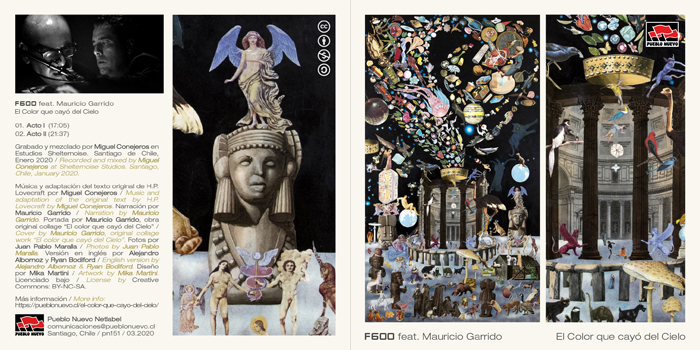[pn151] El Color que cayó del Cielo 2020
by F600 [Chile]
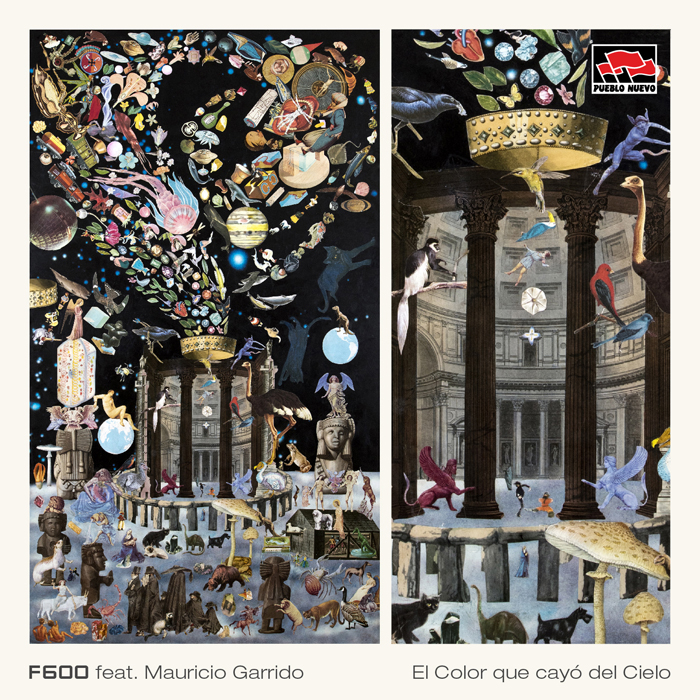
Track list
Pueblo Nuevo Netlabel se complace en presentar el disco “El Color que cayó del Cielo”, del músico y productor chileno F600 feat. Mauricio Garrido.
Pueblo Nuevo Netlabel is pleased to present “El Color que cayó del Cielo”, album by Chilean musician and producer F600 feat. Mauricio Garrido.
Intro:
Toma 1 – Garrido en su estudio descuartizando almanaques una sombría noche de mayo.
Toma 2 – Lovecraft encerrado en su lúgubre habitación escribiendo obsesivamente.
Toma 3 – Conejeros leyendo: “Lovecraft no tenía gran aprecio por la música. Es probable que, además de disfrutar con la Danza Macabra, de Saint-Saëns, también lo hiciera con Una noche en el Monte Pelado, de Músorgski, que relata una tempestad presidida por un demonio.”
Toma 4 – Conejeros, Garrido y Lovecraft cenando a la luz de las velas en Collinswood…
Nadie habla, el ambiente es denso, se puede cortar con el filo de una navaja… Garrido rompe el silencio: “Cacha Howard; Conejeros insiste en manosear tu obra…” Lovecraft responde: “y Bosnia, no???”
Toma 5 – Conejeros en el suelo semi morado atragantado por un trozo de lomo liso.
Toma 6 – Lovecraft y Garrido, bajan corriendo las escaleras de Collinswood, se ve en el umbral de la puerta el metre gritando… “perro muerto, perro muerto!!!”.
Toma 7 – Vemos el comedor vacío en plano general; los platos a medio comer y el cuerpo de Conejeros boca abajo con la silla encima, platos rotos… Corte a negro.
Fin.
Take 1 – Garrido in his study butchering almanacs on a gloomy night in May.
Take 2 – Lovecraft locked in his lugubrious room, obsessively writing.
Take 3 – Conejeros reading: “Lovecraft did not have a great appreciation for music. In addition to enjoying Saint-Saëns’ Macabre Dance, it is probable that he also enjoyed Musorgski’s A Night on bold Mountain, which describes a tempest presided over by a demon”.
Take 4 – Conejeros, Garrido and Lovecraft dining by candlelight in Collinswood…
No one speaks, the atmosphere is dense, it can be cut with a razor’s edge… Garrido breaks the silence: “See Howard, Conejeros insists on handling your work…” Lovecraft replies: “And what about you???”
Take 5 – Conejeros on the floor, semi-blue, choked with a piece of smooth loin.
Take 6 – Lovecraft y Garrido run down the Collinswood’s stairs, on the doorstep the maître shouts… “hey you! pay the bill!!!”
Take 7 – In long shot we see the empty dining room; half-eaten dishes and Conejeros’ body face down with the chair on top, broken plates… Blackout.
End. (**)
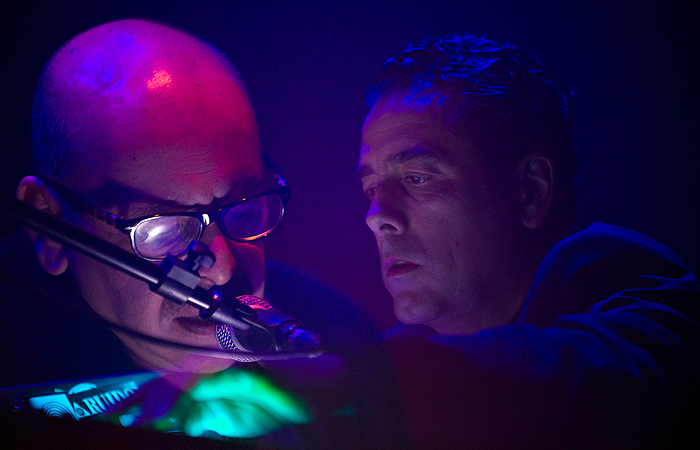
La Pieza / The Piece:
Garrido interpreta plásticamente la obra de Lovecraft y Conejeros los reúne a todos en un mismo espacio sonoro. La evidencia de la distribución de las partes funciona como método justificante de todos y cada uno de los elementos que aquí confluyen generando estados de inquietud, encierro, asombro y ansiedad a partes iguales.
Se entiende este ejercicio performático como una manera de graficar musicalmente lo inconmensurable de una obra literaria (Lovecraft) y de su representación plástica (Garrido); que aquí conversan al compas de las tinieblas musicales. Mundos de mentes perturbadas que aportan vuelo a nuestras rasantes existencias. Se invita al oyente a una inmersión sonora en las profundidades de la narración libre del cuento de H.P. Lovecraft “El color que cayó del cielo”.
La cena está servida. Pase usted.
Garrido visibly interprets the work of Lovecraft and Conejeros brings them all together in the same sound space. The evidence of the distribution of the parts works as the justifying method for each and every one of the elements that come together here, generating states of unease, confinement, amazement and anxiety in equal parts. This performative exercise is understood as a way of graphing musically the immensity of a literary work (Lovecraft) and its visual representation (Garrido); that here converse to the beat of the musical darkness. Worlds of disturbed minds that give flight to our hovering existences. The listener is invited to a sound immersion in the depths of the free narration of the H.P. Lovecraft “The Color Out of Space”.
Dinner is served. Come in. (*)
Miguel Conejeros
(Santiago, Chile. Abril / April 2020)
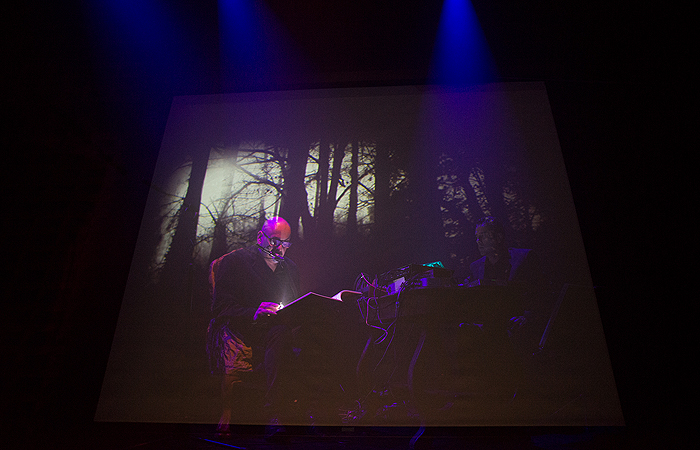
Reseñas / Reviews:
Por Vicente Ruiz.
Colaborar es un ejercicio contemporáneo. La autoría en el arte por medio de un producto común de creación disuelve los límites y las personalidades que se funden. “El Color que cayó del cielo” tiene a H.P. Lovecraft como un primer colaborador al crear la obra literaria el año 1927. Un relato que describe la caída de una energía gigante como la de un meteorito desde el espacio exterior al planeta tierra y que va tiñendo el lugar donde ha caído de un color que es justamente lo contrario, la ausencia de color, uno que es la inexistencia misma, capaz de corroer las formas vivas de una realidad palpable, aunque también la confirmación del nacimiento de un ámbito propio de la subjetividad. Mauricio Garrido interpreta el texto y lo traslada al collage (122 x 69 cm. Exposición LEER 2018) donde se aprecia una columna de vibraciones de color que al llegar a la tierra entra nada menos que en el corazón del edificio del Panteón, lugar icónico justamente por su apertura en la cúpula – ¿el ojo de Dios?- arrasando con una fuerza de abducción simultánea a la que invade, de modo que comienza a subir hacia el infinito todo lo que encuentra, lo mismo que trae materias del espacio para instaurarlas como una conjunción de materias y almas.
Con el texto original y la obra plástica, Miguel Conejeros crea una composición musical que refleja nítidamente el viaje de una fuerza monstruosa que viene cayendo del cielo. Una voz va relatando los hechos del impacto que ejerce y que poco a poco va transformando el paisaje, haciendo nacer un páramo gris, que se expande justamente en el espacio y la vida de los protagonistas, descrito a través de la voz del mismo Garrido, que acerca del él mismo como personaje central de la historia actúa de puente entre la literatura y el sonido, la creación visual que él ha hecho nacer, llegando a ocupar el lugar de un mediador que vislumbra en la creación la posibilidad de la magia.
La obra musical logra plasmar ampliamente el terror que ha puesto Lovecraft en la obra literaria. Los distintos momentos se disparan en una especie de ficción futurista que toma los aspectos clásicos de una obra de audio y que a la vez los reúne para dar paso a una creación que arriba a lo humano, no sólo por su capacidad para generar realidades, además, de proponer una certeza sonora, que se multiplica en direcciones disímiles aunque armónicas, donde se conmueven las estructuras íntimas de la música en comunidad con las letras y la creación plástica.
La contemporaneidad se manifiesta en la colaboración artística de estos tres creadores: Lovecraft, Conejeros y Garrido. Los misterios descritos a través de lo audible son parte del mundo como se vislumbra hoy: grandes territorios devastados que se desplazan como una peste destructiva donde no suele quedar nada o muy poco de manera de reiniciar la vida o al menos de continuarla. Espacios donde lo siniestro se alza con fines ominosos. Y el viaje se manifiesta como desplazamiento de formas y sentidos.
Sin embargo, el placer se impone, uno que surge desde adentro de los sonidos y sus relaciones. Uno que arrastra la obra visual de Mauricio Garrido y al pasar por la sensibilidad de Miguel Conejeros, dan paso a un torrente inevitable de luces en medio de las sombras, lo inexistente confirmando lo existente, lo que se destruye como parte de la forma y el vacío como un síntoma del universo.
Collaborating is a contemporary exercise. Authorship in art through a common creation outcome dissolves the limits and merges personalities. “El Color que cayó del cielo” (The Colour out of Space) has H.P. Lovecraft as the first collaboratorby creating the literary work in 1927. A story that describes the fall of a giant energy like a meteorite from outer space to planet Earth; the energy stains the place where it has fallen with a colour that is just the opposite, in fact it is the absence of colour and which is non-existence itself, capable of corroding the living forms of a palpable reality, although the confirmation of the birth of a proper field of subjectivity as well. Mauricio Garrido interprets the text and transfer it to collage (122 x 69 cm. Expo LEER 2018) where is possible to see a column of colour vibrations that upon reaching the earth enters nothing less than to the heart of the Pantheon building, iconic place precisely for its opening in the dome – The eye of God?- sweeping with a force of abduction simultaneous to the one that invades, so everything he finds begins to rise to infinity, bringing at the same time materials from space to establish them as a conjunction of materials and souls.
From the original text and the collage, Miguel Conejeros creates a musical composition that reflects the journey of a monstrous force that is falling from the sky in a sharply way. A voice recounts the events of the impact that is gradually transforming the landscape, giving birth to a gray wasteland which expands precisely in the space and life of the protagonists. This is described through Garrido’s voice, who is a central character in the story acting as a bridge between literature, sound and the visual workthat he himself gave birth to, coming to occupy the place of a mediator who glimpses within creation the possibility of magic.
The musical work manages to fully capture the terror that Lovecraft has put in the literary work. The different moments are shot in a kind of futuristic fictionthat takes the classic aspects of an audio work and at the same time brings them together to make way for a creation that reaches the human, not only for its ability to generate realities, but also by proposing a sound certainty which multiplies in different but harmonic directions, where the intimate structures of music are moved in community with the lyrics and the plastic creation.
Contemporaneity is manifested in the artistic collaboration of these three creators: Lovecraft, Conejeros and Garrido. The mysteries described through the audible are part of the world as is seen today: large devastated territories that move like a destructive plague where there is usually nothing or very little left to restart life or at least continue it. Spaces where the sinister rises with ominous aims. And the journey manifests as displacement of forms and senses.
However, pleasure prevails, one that arises from within the sounds and their relationships. One that drags Mauricio Garrido’s visual work and passing through the sensitivity of Miguel Conejeros and gives way to an inevitable torrent of lights in the midst of shadows, the non-existent confirming the existent, what is destroyed as part of the shapeand emptiness as a symptom of the universe. (**)
Vicente Ruiz
(Santiago, Chile. Abril / April 2020)
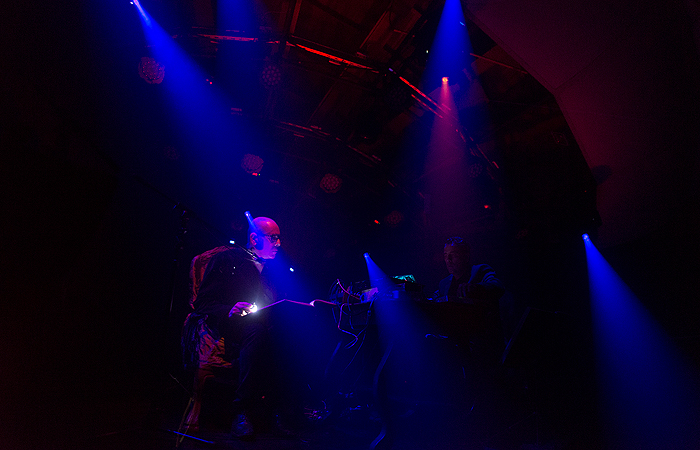
El que sueña en R´lyieh, por Mauricio Garrido.
Para Lovecraft el lugar que ocupa el hombre en el universo es insignificante, una temblorosa cabeza de fósforo encendida en el pavoroso infinito en donde viven los dioses eternos que desconocen límites de tiempo, forma y moral, y que pueden dormir durante eones esperando su oportunidad para despertar y engullir el cosmos entero. Como lectores humanos de su obra estamos sometidos al terror más absoluto, el terror a lo desconocido. el terror de nuestra propia finitud e intrascendencia frente a la monstruosa edad y tamaño del universo, en donde para los dioses inmortales no somos más importantes de lo que para nosotros lo sería un insecto o una célula. Esta es una visión contemporánea, llamémosle literaria, del relato de horror que hunde sus pies en oscuras zonas de la tradición oral de la creación y la relación del hombre con los Dioses Primigenios y desde la Ciencia Ficción en su visión fría y ominosa de un cosmos acechante y devorador que se revuelve sobre sí mismo, como lo hacen el Ctulhu o Nyarlathotep bailando en las profundidades del mar o en planetas enfermizamente lejanos y antiguos.
Para Lovecraft, igual que lo fue para Poe, su gran maestro espiritual, el tener la constante sensación de haber nacido en un país y tiempo equivocados más una abismante soledad personal de casi total reclusión, produjo en su literatura una fuerte sensación de “otredad”, en el sentido de no pertenencia, y de evasión hacia inexpugnables pasados arcaicos en donde la existencia humana ni siquiera hubiese sido pensada y donde el vasto espacio y sus planetas eran el campo de batalla de horrorosas entidades, distintas al ser humano hasta el paroxismo de lo diferente, donde su forma de desplazarse, su color y su lenguaje harían explotar la mente y el alma de algún desafortunado testigo que encontrase en su aventura algún vestigio de tales mundos, enterrados y fuera de nuestro alcance por misericordia del destino y guardados celosamente por peligrosos e impenetrables cultos secretos, adoradores de los primeros reales habitantes de nuestra galaxia, a quienes jamás dejan de intentar despertar con algún atroz conjuro extraído de libros execrables, portales seguros a la locura y la perdición de las almas, como adivinando que solo somos el sueño de alguien más que duerme esperando su oportunidad de despertar en las profundidades de la sumergida ciudad de R´lyeh.
The one who dreams in R´lyieh, by Mauricio Garrido.
For Lovecraft, the place man occupies in the universe is insignificant, a trembling matchstick lit in the dread infinity where the eternal gods live, unaware of the limits of time, form and morals, sleeping for eons waiting for their opportunity to awaken and gobble up the entire cosmos. As human readers of his work we are subject to the most absolute terror, the terror of the unknown. the terror of our own finitude and insignificance in the face of the monstrous age and size of the universe, where for the immortal gods we are not more important than an insect or a cell would be for us. This is a contemporary vision, let’s call it literary, of the horror story that sinks its feet in dark areas of the oral tradition of creation and man’s relationship with the Primitive Gods and of Science Fiction in its cold and ominous vision of a lurking and devouring cosmos that revolves around itself, as they make the Ctulhu or Nyarlathotep go dancing in the depths of the sea or on sickly distant and ancient planets.
For Lovecraft, just as it was for Poe, his great spiritual teacher, having the constant feeling of having been born in the wrong country and time in addition to an abysmal personal solitude of almost total seclusion, produced in his literature a strong feeling of “otherness”, in the sense of non-belonging, and evasion towards impregnable archaic pasts where human existence had not even been thought of and where vast space and its planets were the battlefield of horrifying entities, distinct from the human being to the paroxysmal extent of difference, where their way of moving, their color and their language would exploit the mind and soul of some unfortunate witness who found in his adventure some vestige of such worlds, buried out of our reach by the mercy of fate and jealously, guarded by dangerous and impenetrable secret cults, worshipers of the first real inhabitants of our galaxy, whom they never stop trying to awaken with some atrocious incantation drawn from execrable books, secure portals to madness and the downfall of souls, as if guessing that we are only the dream of someone else who sleeps waiting for his chance to wake up in the depths of the submerged city of R´lyeh. (*)
Mauricio Garrido
(Santiago, Chile. Abril / April 2020)
Biografía Mauricio Garrido:
El mundo del artista visual Mauricio Garrido (Santiago de Chile, 1974) es surrealista, exuberante, complejo y oscuro al mismo tiempo, su trabajo ha sido catalogado muchas veces como neo-barroco y abarca diversos medios tales como la escultura, el collage, textiles y video arte. Su obra revisa los códigos de representación a lo largo de la historia del arte, y está particularmente centrada en la figura de la alegoría como un método de narración sintetizada. Su producción artística se ha exhibido en Europa, Asia y América Latina y su obra está en diversas colecciones particulares, como la del Museo Diego Rivera Anahuacalli, México, y la del cantante y coleccionista Elton John.
The world of visual artist Mauricio Garrido (born in Santiago de Chile 1974) is surreal, exuberant, complex and dark at the same time, his work has been cataloged many times as neo-baroque and covers various media such as sculpture, collage, textiles and video art. His work reviews the codes of representation throughout art history, and is particularly focused on the figure of allegory as a method of synthesized narration. His artistic production has been exhibited in Europe, Asia and Latin America and his work is in various private collections, such as that of the Diego Rivera Anahuacalli Museum, Mexico, and that of the singer and collector Elton John. (*)
Track List:
01. Acto I (17:05)
02. Acto II (21:37)
Tiempo total / total play: 38:42
Estilo / Genre:
Experimental | Narration | Soundtrack
BAJA GRATIS EN MP3/FLAC DESDE / FREE DOWNLOAD MP3/FLAC AT:
https://pueblonuevo.cl/el-color-que-cayo-del-cielo/
https://archive.org/details/pn151
INFORMACIÓN DEL DISCO / RELEASE INFO:
Release “El Color que cayó del Cielo” [pn151], 04.2020.
Copyright: Licenciado para el público bajo Creative Commons:
Reconocimiento – No Comercial – Compartir igual – 3.0
http://creativecommons.org/licenses/by-nc-sa/3.0/
Créditos / Credits:
Grabado y mezclado por / Recorded and mixed by Miguel Conejeros en / in Estudios Shelternoise. Santiago de Chile, enero / January 2020.
Música y adaptación del texto original de H.P. Lovecraft por / Music and the adaptation of the original text by H.P. Lovecraft by Miguel Conejeros.
Narración por / Narration by Mauricio Garrido.
Portada por / Cover by Mauricio Garrido, obra original collage / original work collage “El color que cayó del Cielo” (Collage 122 x 69 cm. Exposición individual / solo expo LEER, Centro Cultural Las Condes, 2018).
Fotos por / Photos by Juan Pablo Maralla.
(*) Versión en inglés por / English version by Ryan Bodiford.
(**) Versión en inglés por / English version by Alejandro Albornoz.
Diseño por / Artwork by Mika Martini.
 Otros comentarios + artículos + reseñas / Other comments + articles + reviews Otros comentarios + artículos + reseñas / Other comments + articles + reviews |
||
| 09.12.2020 | online podcast | Llums de Tunguska – programa 183 – Especial monográfico Pueblo Nuevo (1/3) |
| 08.05.2020 | online interview | F600: el Color del Sonido – El ruido es el mensaje radioshow |
| 03.04.2020 | online interview | Entrevista a F600 – ciudadsonora.cl |
| 03.04.2020 | online review | djprofile.tv |
| 03.04.2020 | online review | www.cavila.cl |
| 03.04.2020 | online review | www.clongclongmoo.org |
